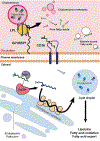Fat, Obesity, and the Endothelium
- PMID: 31976384
- PMCID: PMC6977949
- DOI: 10.1016/j.cophys.2019.09.003
Fat, Obesity, and the Endothelium
Abstract
Endothelial cells line all blood vessels in vertebrates. These cells contribute to whole-body nutrient distribution in a variety of ways, including regulation of local blood flow, regulation of trans-endothelial nutrient transport, and paracrine effects. Obesity elicits dramatic whole-body nutrient redistribution, in particular of fat. We briefly review here recent progress on understanding endothelial fat transport; the impact of obesity on the endothelium; and, conversely, how endothelial function can modulate obesity.
Conflict of interest statement
Conflict of interest statement The authors declare no conflicts.
Figures


Similar articles
-
Regulation of coronary blood flow during exercise.Physiol Rev. 2008 Jul;88(3):1009-86. doi: 10.1152/physrev.00045.2006. Physiol Rev. 2008. PMID: 18626066 Review.
-
Body fat distribution and flow-mediated endothelium-dependent vasodilation in older men.Int J Obes Relat Metab Disord. 2002 May;26(5):663-9. doi: 10.1038/sj.ijo.0801972. Int J Obes Relat Metab Disord. 2002. PMID: 12032751
-
Body fat distribution predicts the degree of endothelial dysfunction in uncomplicated obesity.Int J Obes Relat Metab Disord. 1999 Sep;23(9):936-42. doi: 10.1038/sj.ijo.0801022. Int J Obes Relat Metab Disord. 1999. PMID: 10490799
-
Effects of acquired obesity on endothelial function in monozygotic twins.Obesity (Silver Spring). 2006 May;14(5):826-37. doi: 10.1038/oby.2006.96. Obesity (Silver Spring). 2006. PMID: 16855192
-
Cooperation of liver cells in health and disease.Adv Anat Embryol Cell Biol. 2001;161:III-XIII, 1-151. doi: 10.1007/978-3-642-56553-3. Adv Anat Embryol Cell Biol. 2001. PMID: 11729749 Review.
Cited by
-
Diabetes pathogenesis and management: the endothelium comes of age.J Mol Cell Biol. 2021 Oct 21;13(7):500-512. doi: 10.1093/jmcb/mjab024. J Mol Cell Biol. 2021. PMID: 33787922 Free PMC article.
-
Serum vascular endothelial growth factor b and metabolic syndrome incidence in the population based cohort Di@bet.es study.Int J Obes (Lond). 2022 Nov;46(11):2013-2020. doi: 10.1038/s41366-022-01212-1. Epub 2022 Aug 20. Int J Obes (Lond). 2022. PMID: 35987953 Free PMC article.
-
Short-term high-fat diet intake leads to exacerbation of concanavalin A-induced liver injury through the induction of procoagulation state.Biochem Biophys Rep. 2020 Feb 12;22:100736. doi: 10.1016/j.bbrep.2020.100736. eCollection 2020 Jul. Biochem Biophys Rep. 2020. PMID: 32083190 Free PMC article.
-
MEBOCOST maps metabolite-mediated intercellular communications using single-cell RNA-seq.Nucleic Acids Res. 2025 Jun 20;53(12):gkaf569. doi: 10.1093/nar/gkaf569. Nucleic Acids Res. 2025. PMID: 40568942 Free PMC article.
-
Lipedema: Insights into Morphology, Pathophysiology, and Challenges.Biomedicines. 2022 Nov 30;10(12):3081. doi: 10.3390/biomedicines10123081. Biomedicines. 2022. PMID: 36551837 Free PMC article. Review.
References
-
- Arita Y, Kihara S, Ouchi N, Takahashi M, Maeda K, Miyagawa J. i., Hotta K, Shimomura I, Nakamura T, Miyaoka K, et al. (1999). Paradoxical Decrease of an Adipose-Specific Protein, Adiponectin, in Obesity. Biochemical and Biophysical Research Communications 257, 79–83. - PubMed
-
- Beigneux AP, Davies BSJ, Gin P, Weinstein MM, Farber E, Qiao X, Peale F, Bunting S, Walzem RL, Wong JS, et al. (2007). Glycosylphosphatidylinositol-Anchored High-Density Lipoprotein-Binding Protein 1 Plays a Critical Role in the Lipolytic Processing of Chylomicrons. Cell Metabolism 5, 279–291. - PMC - PubMed
-
- Bianconi E, Piovesan A, Facchin F, Beraudi A, Casadei R, Frabetti F, Vitale L, Pelleri MC, Tassani S, Piva F, et al. (2013). An estimation of the number of cells in the human body. Annals of Human Biology 40, 463–471. - PubMed
Grants and funding
LinkOut - more resources
Full Text Sources
